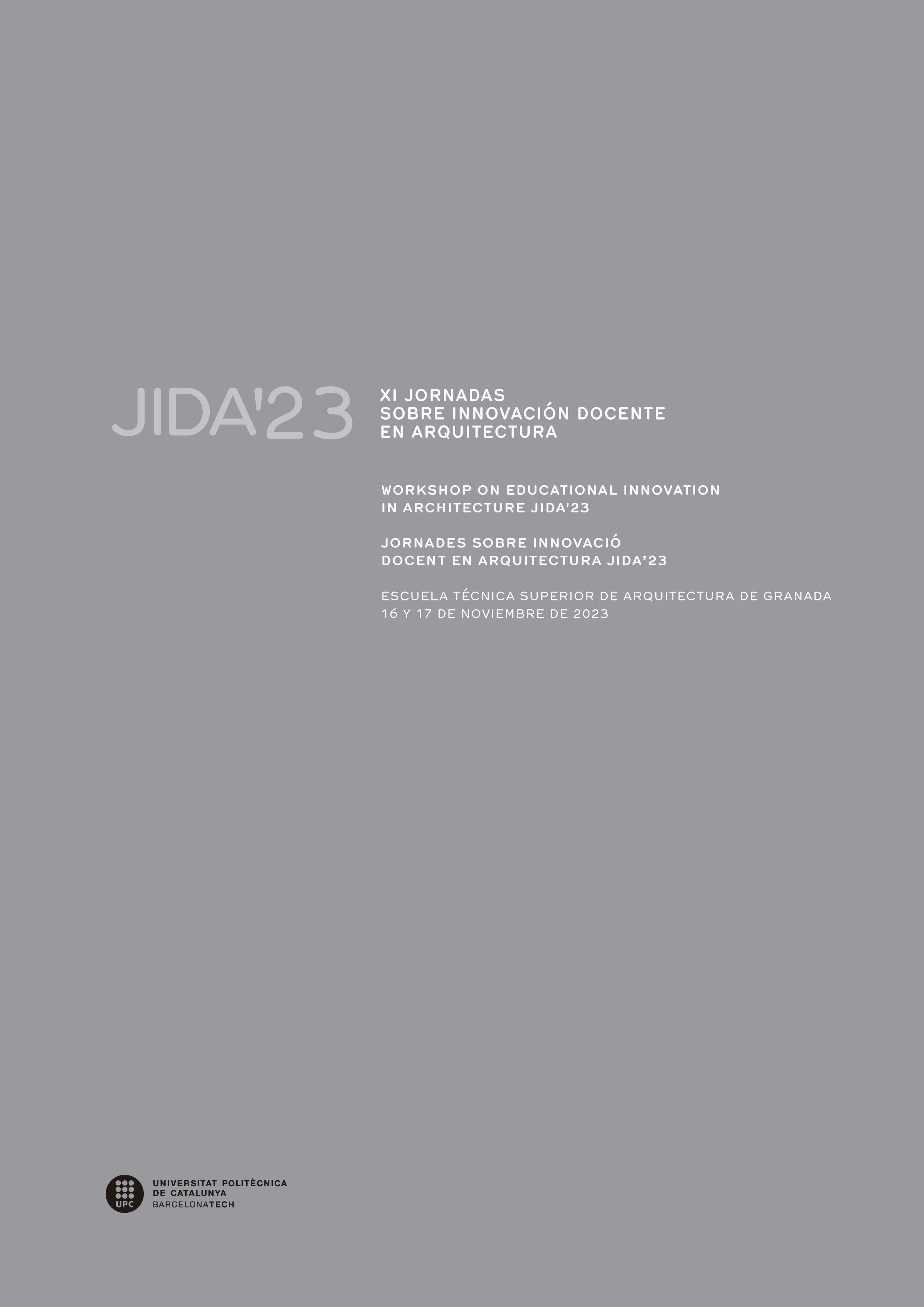Dispositivos versus Simuladores en la iniciación al proyecto arquitectónico
DOI:
https://doi.org/10.5821/jida.2023.12292Palabras clave:
iniciación, propedéutica, proyecto arquitectónico, técnicas docentes, experimentaciónResumen
El artículo contrasta y reflexiona sobre dos maneras de iniciar el aprendizaje de la arquitectura: por medio de proyectos que simulan o reproducen la práctica profesional del arquitecto (Simuladores), y mediante ejercicios que exploran y experimentan con diversas técnicas docentes, materiales, entornos, procesos de trabajo y temas disciplinares que familiarizan a los estudiantes con el mundo de la arquitectura de manera menos evidente (Dispositivos). Plantea tres cuestiones principalmente. Primero, cuestiona si los Simuladores son la única manera válida de iniciar el aprendizaje de proyectos. Segundo, sugiere que la pedagogía inicial de proyectos arquitectónicos está estrechamente relacionada con la experimentación. Y tercero, defiende que los Dispositivos, aunque no solicitan a los estudiantes la proyección de edificios, implican la comprensión y el desarrollo de temas y habilidades fundamentales para la práctica del proyecto arquitectónico.
Citas
Angélil, M. 2003. Inchoate: an experiment in architectural education. Zürich: Swiss Federal Institute of Technology, Department of Architecture.
Angélil, M. 1990. "Experimentation as Modus Operandi. An Investigation of Design Process: The Los Angeles Art Park", Journal of Architectural Education, vol. 44 (no. 1), pp. 37-48.
Angélil, M. 2003, Inchoate: an experiment in architectural education, Zürich Swiss Federal Institute of Thecnology, Departament of Architecture,
Barnett Johnston, G. 2012. "Professional practice", En: Architecture school: three centuries of educating architects in North America, editado por: J. Ockman y R. Williamson, pp. 370-373. Cambridge, Massachusetts: MIT Press.
Briggs, M.S. 1927. The architect in history. Oxford: Clarendon Press.
Cuff, D. 1991. Architecture: the story of practice. Cambridge, Massachusetts: MIT Press.
Dutton, T.A. & Willenbrock, L.L. 1989. "Reviewed Work(s): The Design Studio: An Exploration of Its Traditions and Potential by Donald Schön", Journal of Architectural Education, vol. 43 (no. 1), pp. 53-55.
Dutton, T.A. 1987. "Design and Studio Pedagogy", Journal of Architectural Education, vol. 41 (no. 1), pp. 16-25.
Dutton, T.A. 1991. "Introduction: Architectural Education, Postmodernism, and Critical Pedagogy". En: Voices in architectural education: Cultural politics and pedagogy, editado por: T.A. Dutton(ed), pp. xv-xxix. New York: JF Bergin & Garvey.
Kostof, S. (ed). 1977. The Architect: Chapters in the History of the Profession. New York: Oxford University Press.
Lee Camacho, J. I. 2017. El enunciado como dispositivo pedagógico en la introducción al proyecto arquitectónico contemporáneo. Tesis Final de Máster. Escuela Técnica Superior de Arquitectura de Madrid, Universidad Politécnica de Madrid. Repositorio institucional.
Lee Camacho, J. I. 2022. “Dispositivos pedagógicos de iniciación al proyecto arquitectónico”. Revista de Arquitectura, 27(43), pp. 120-139.
Lee Camacho, J. I. 2022. Dispositivos pedagógicos de iniciación al proyecto arquitectónico: entre el Basic Design y los simuladores. Tesis Doctoral. Escuela Técnica Superior de Arquitectura de Madrid, Universidad Politécnica de Madrid.
Masdéu Bernat, M. 2016. "La enseñanza de la arquitectura en la sociedad actual. La integración de las nuevas formas de práctica profesional en el Taller de Arquitectura", rita, (no. 5), pp. 72-79.
Masdéu Bernat, M. 2017. La transformación del Taller de Arquitectura en nuevos espacios de aprendizaje. Un estudio sobre el proceso de integración entre la enseñanza y la práctica profesional. Tesis Doctotal. Universitat de Girona.
Monedero Isorna, J. 2002. Enseñanza y práctica profesional de la arquitectura en Europa y Estados Unidos: estudio comparativo sobre la situación en el año 2000. Barcelona: Departament d'Expressió Gràfica Arquitectónica. Escola Tècnica Superior d'Arquitectura de Barcelona.
Norberg-Schulz, C. 1965. Intentions in architecture. Cambridge, Mass.: M.I.T.
Psegiannaki, A.E. 2015. Contextualización teórica del acto pedagógico en la enseñanza y el aprendizaje del proyecto arquitectónico: el caso de la E.T.S.A.M. Tesis Doctoral. Escuela Técnica Superior de Arquitectura de Madrid, Universidad Politécnica de Madrid.
Salama, A.M. 1995. New trends in architectural education: designing the design studio. Raleigh, N.C.: Tailored Text & Unlimited Potential Pub.
Salama, A.M. 2015. Spatial Design Education: new directions for pedagogy in architecture and beyond. New York: Ashgate.
Schön, D. A. 1983. The Reflective Practitioner: How professionals think in action, New York: Basic Books.
Schön, D. A. 1985. The design studio: an exploration of its traditions and potentials, London: RIBA Publications.
Seguí de La Riva, J. 2011. Optimización de la ejercitación (2), Madrid: Cuadernos del Instituto Juan de Herrera.
Seguí de La Riva, Javier. 2010. Acerca de la enseñanza del proyectar, Madrid: Cuadernos del Instituto Juan de Herrera.
Souto, M. 1999. "Los dispositivos pedagógicos desde una perspectiva técnica", en: Grupos y dispositivos de formación, editado por: M. Souto & et al. pp. 89-111. Buenos Aires: Novedades Educativas.
Vidler, A. 2004. "Anthony Vidler". En: Back to school: Architectural education, the information and the argument. Architectural design profile 171, editado por: M. Chadwick, pp. 13-23. London: Wiley-Academy,
Webster, H. 2004. "The design diary: promoting reflective practice in the design studio", En: Monitoring Architectural Design Education in European Schools of Architecture, EAAE-Transactions on Architectural Education, V-17, editado por: C. Spiridonidis, pp. 343-356. Delft: DUP Science,
Webster, H. 2008. "Architectural education after Schön: Cracks, blurs, boundaries and beyond", Journal for Education in the Built Environment, vol. 3 (no. 2), pp. 63-74.






















